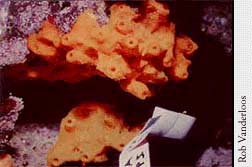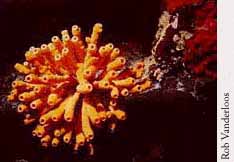



Sponges wage chemical warfare in the Indo-Pacific.
The bright orange sponge Jaspis johnstoni and the equally brilliant Orange Marley appear misleadingly vulnerable. Soft and fleshy, fixed to the surface of a rock, they could be easy meals for predators. But most sea creatures, including the two-foot blue parrot fish that scrapes chunks out of the adjacent coral, rightly refuse to eat them. These sponges store chemical weapons that discourage hungry neighbors from taking more than one bite.
The chemicals that can kill a sponge predator can also kill other living clumps of cells, such as the tumors that on occasion root in our bodies. Each sponge harbors a chemical poised to kill. In the laboratory, Jaspis's secret weapon, the chemical called jasplakinolide, inhibits the growth of a wide array of cancer cells, including breast and prostate.
Researchers at the National Cancer Institute (NCI) in Bethesda, Maryland, have begun to decipher Jasplakinolide's killer strategy. The toxin sneaks into cells and attaches to an abundant and crucial protein called actin in the cell's backbone, or cytoskeleton.

The sponge Jaspis johnstoni stockpiles a
potent defense chemical.Jasplakinolide disrupts the normal functions of a cell's actin cytoskeleton. The cytoskeleton's network of filaments, like our bones, gives cells their shape and mobility. The cytoskeleton plays an important role in cell division as well, cinching a cell at its midline until the single cell cleaves in two. The toxin intrudes by tenaciously sticking to actin and forcing it to link together in longer and longer actin filaments. After exposure to the toxin, cancer cells often have four nuclei, meaning they should have divided twice, but couldn't.
Jasplakinolide's grasp on actin makes it a potent toxin. It's a wonder the sponge itself survives it. The key to whether jasplakinolide will be a useful drug, though, will be in finding the right dosage and an administrative route that minimizes the destruction of healthy tissue as the toxin shrinks tumors. Jasplakinolide has begun what could be a decade-long stint in preclinical and clinical cancer trials at the NCI. The chemical still has "a long way to go," Crews says, before--or if--it becomes an anti-cancer drug.
In the meantime, scientists have found another use for jasplakinolide. The toxin's hold on actin provides scientists a useful method to examine the actin cytoskeleton. Crews has supplied a biotechnology company called Molecular Probes in Eugene, Oregon, with an aliquot of this toxin to sell to cellular biologists.

The Orange Marley is deadly. The Orange Marley sponge illustrates a familiar problem for natural products chemists--its weapon is not only lethal, it is swift. The poison, called Milnamide B (after the collection site of this sponge in Milne Bay of Papua New Guinea), kills test mice before it has a chance to work on their tumors. Crews has dropped Milnamide B as a potential anti-cancer drug because this toxin performs its job too well.



